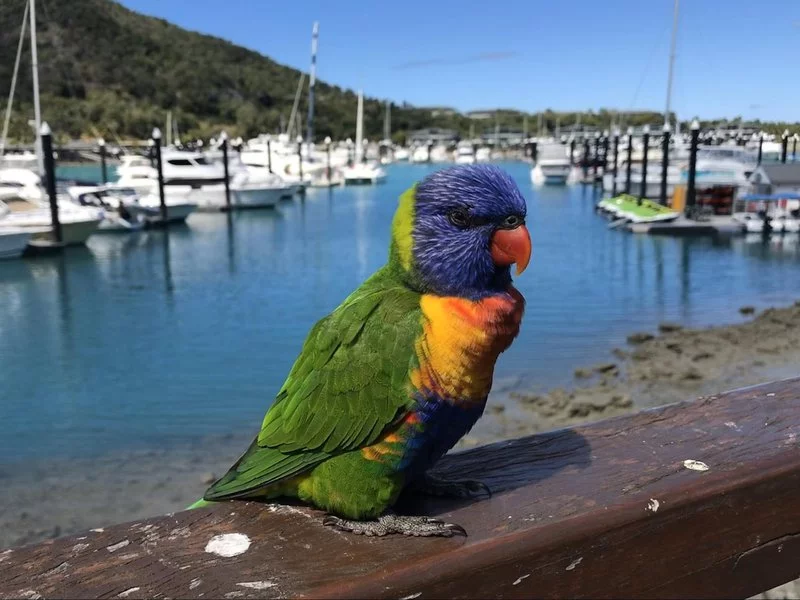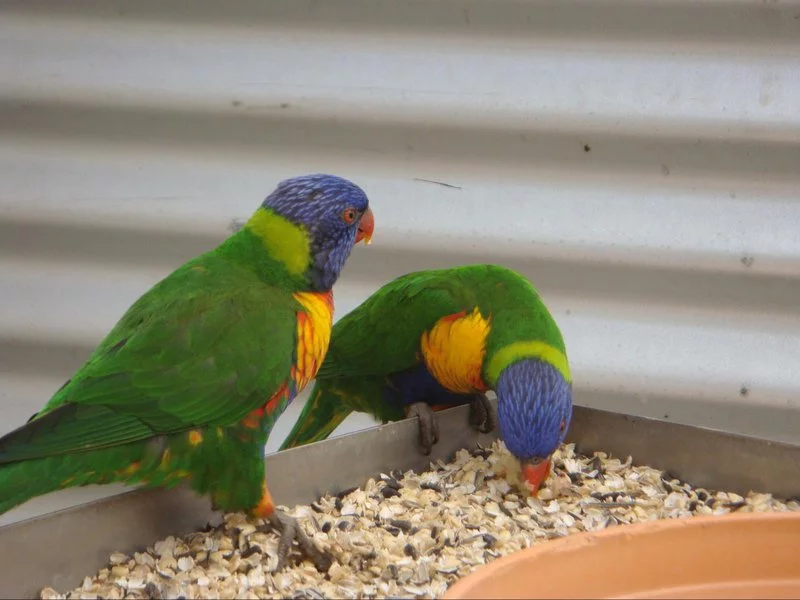Rainbow lorikeets are classed as true parrots and belong to a small group of parrots called Loriini. The birds in this group are small to medium sized and have the characteristic sharp curved beak of all parrots. However they have one feature which sets them apart from other parrots, their tongue. The tongue of birds in the loriini group has a papillate tip which gives it a brush-like appearance. This allows these birds to specialise in feeding on nectar from flowers and also soft fruits.
Rainbow lorikeets embody the typical image that comes to mind when one thinks of parrots. As the name suggests they are brightly multicoloured and those that have seen the will attest to this species striking colouring. They also possess the high level of intelligence that goes hand in hand with birds in the parrot family. Due to their beauty and smarts they are quite popular pets as they are easy to train and can be taught different tricks and habits. Their intelligence also means that they are extremely social and can form quite strong and emotional bonds with owners.
The plumage of this species is just as they are named, a rainbow. They have a blue head and belly, bright green wings, back and tail, and orange/red and yellow mottled breast. When they take flight and open their wings the stunning rainbow continues. The underside of the wings is coloured with red at the base and then a row of yellow. Juveniles of this species have a back beak which turns to bright orange as they reach adulthood. Males and females are not sexually dimorphic which means that both sexes look the same in both appearance and size. Once they are fully grown adult rainbow lorikeets can reach lengths of up to 30 centimetres from beak to the end of the tail and weigh in at 175 grams.

These beautiful parrots are native to the east coast of Australia and Tasmania and due to being introduced, can also be found in Western Australia. They are very well adapted to living in a wide range of habitats including woodlands, rainforests and also urban environments which are heavily treed. The trees are vital to the rainbow lorikeet as this is where they will build their nests, the nests are usually tree hollows lined with chewed and decayed wood. The rainbow lorikeets are very protective of their nest areas and breeding pairs will defend it quite aggressively. These birds are also largely monogamous so a breeding pair will often stay together for life.
The breeding pairs have a strong bond and will spend the majority of their time together, they will even feed as a pair. The diet of these birds mainly consists of pollen and nectar and fruit from native plants . Their specialised tongue enables them to extract the pollen and nectar from inside the flowers. Due to their close proximity to humans, rainbow lorikeets will also eat a variety of seeds and non native fruits such as apples and grapes, from backyard bird feeders. Their love of fruit has also caused them to become somewhat of a pest to the agricultural industry as they will feed on and cause damage to fruit crops.

Their pest status is particularly true in the south west of Western Australia where the rainbow lorikeet was accidentally introduced in the 1960s. Not only do they cause damage to fruit crops but they also compete with native bird species for food and nesting sites, often pulling the chicks of native birds out of nest hollows so that they can use them. Due to their success at populating regions outside their native range and their ability to adapt to the ever expanding urban environment, this species is of least concern from a conservation standpoint. They are one of the most commonly and widely observed bird species in Australia.
The Whitsundays is no exception. With an abundance of native plants and lush rainforest type habitats the whitsunday region is the perfect environment for the rainbow lorikeet. This beautiful parrot can be seen flitting from tree to tree feeding on fruits and flowers. You may also be lucky enough to see them flying as a flock. They are also a common sight in backyards with native trees and plants, or in those backyards where fresh fruit and seeds are put out for them. It is important to note that If you are going to feed these birds, processed human food such as bread is not used. These foods do not provide the lorikeets with the nutrients that they need and can be quite harmful to them.


